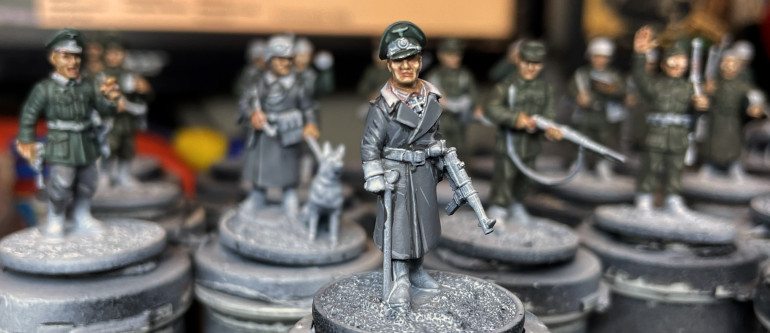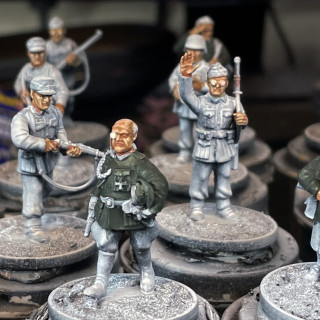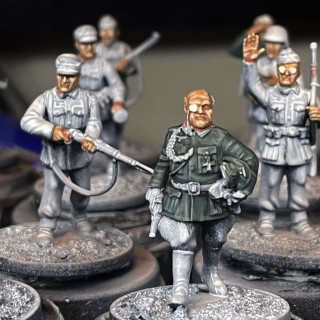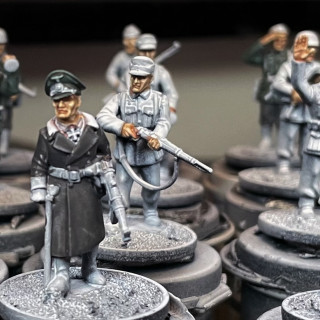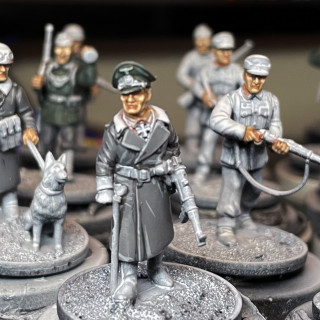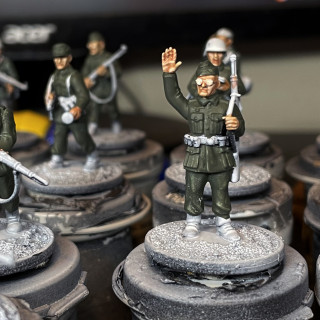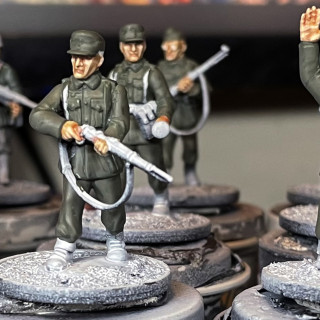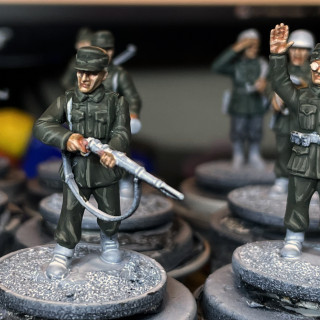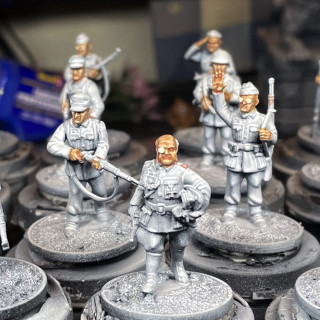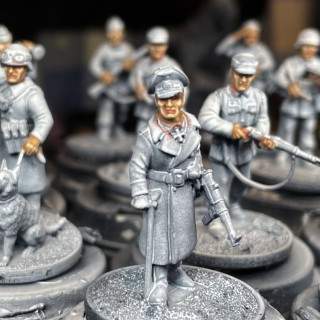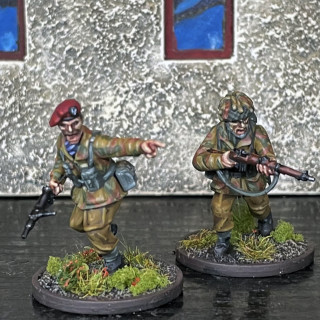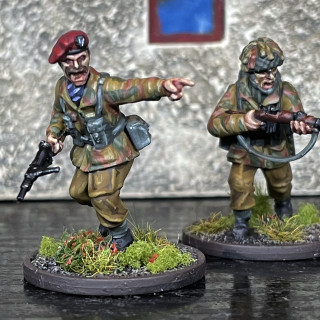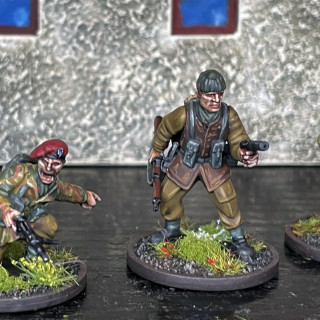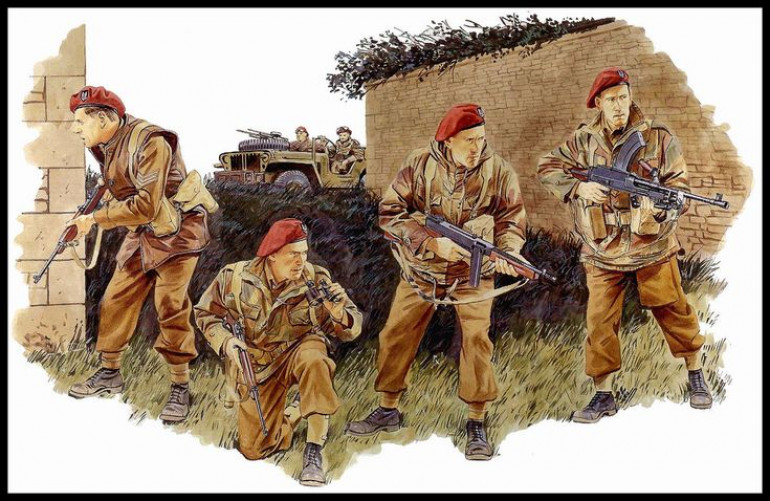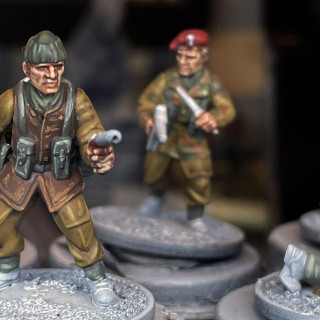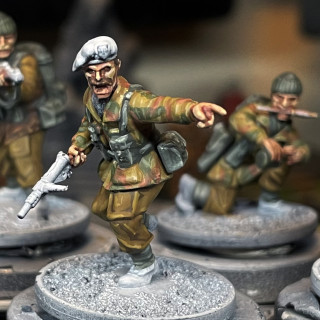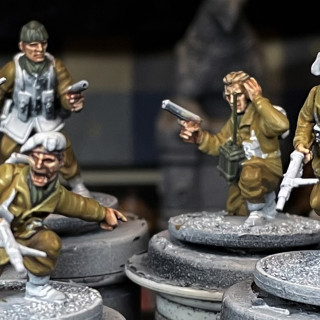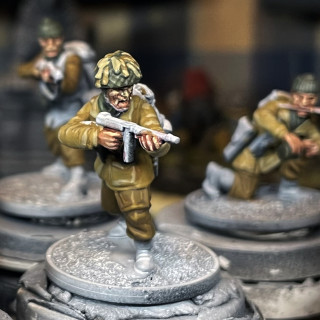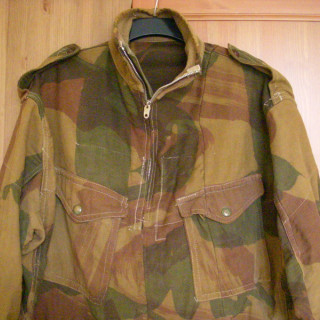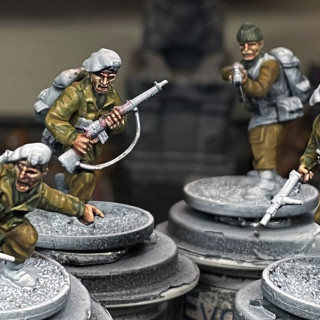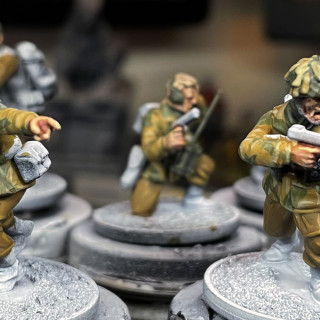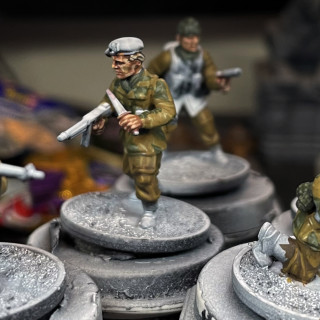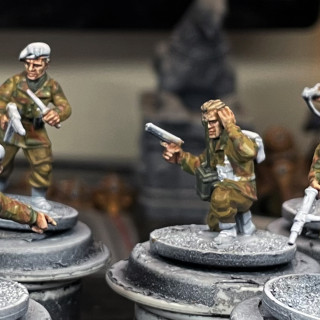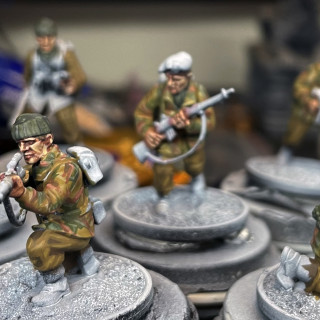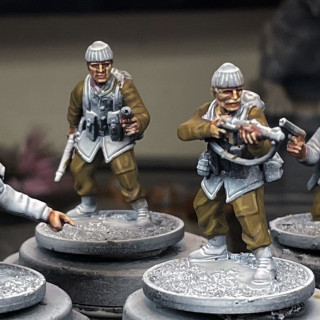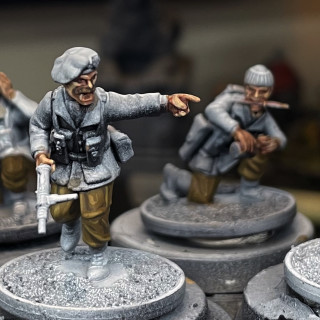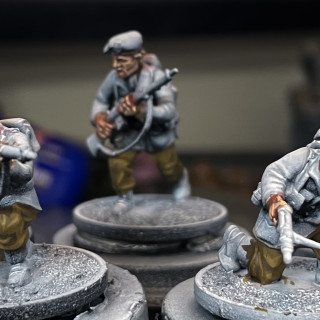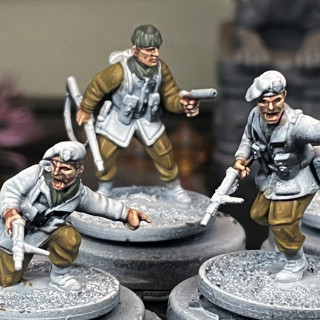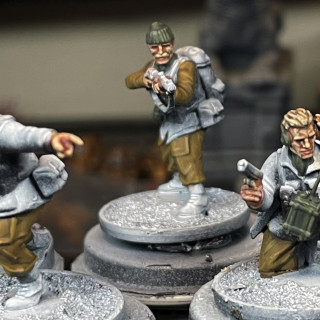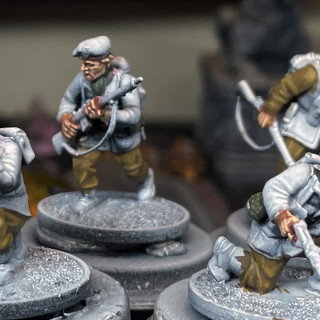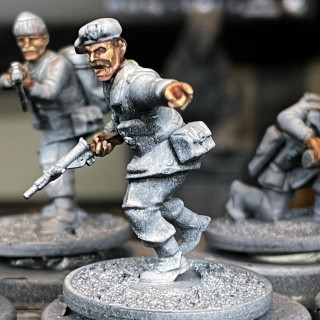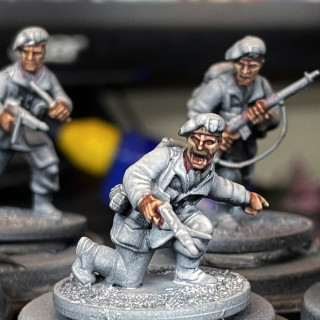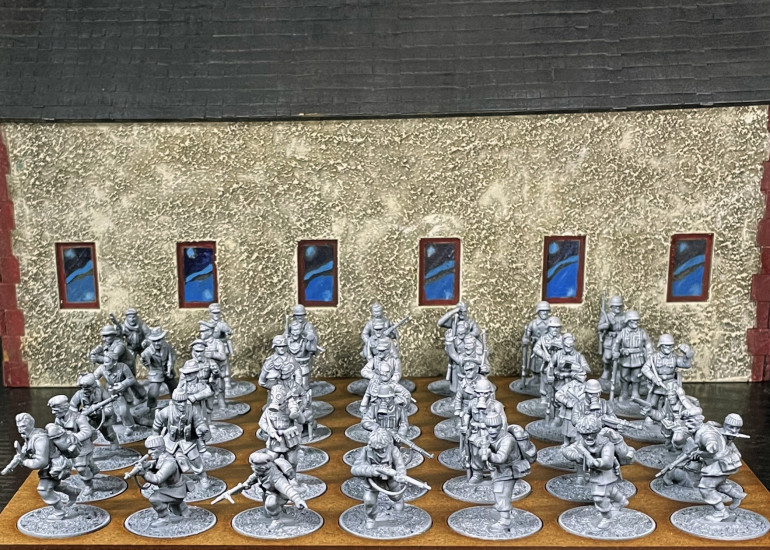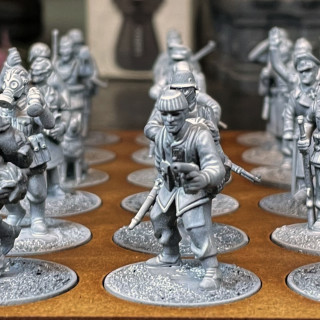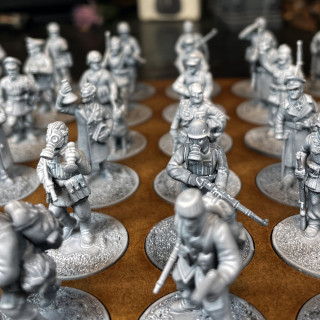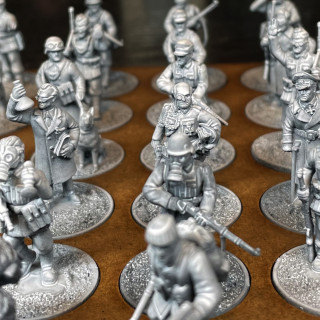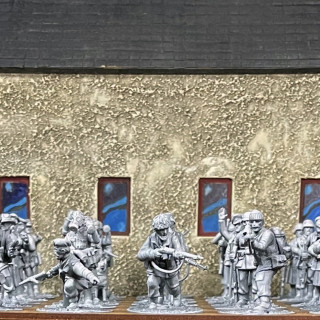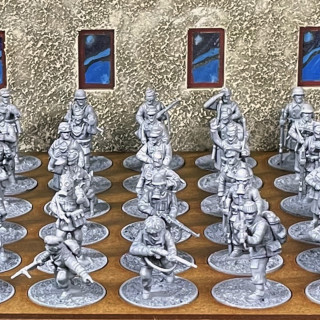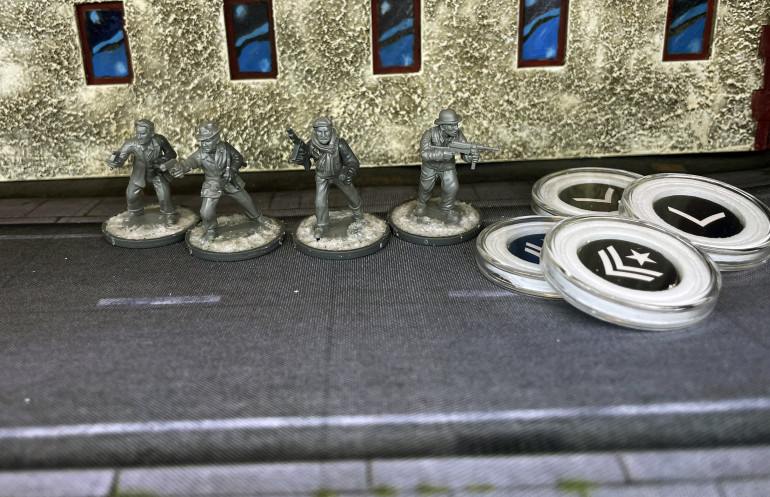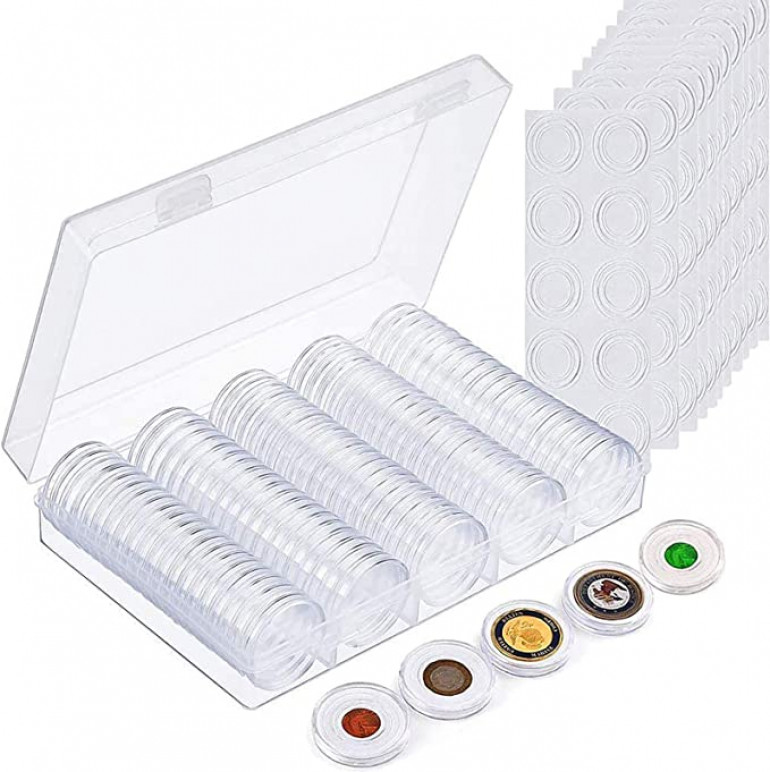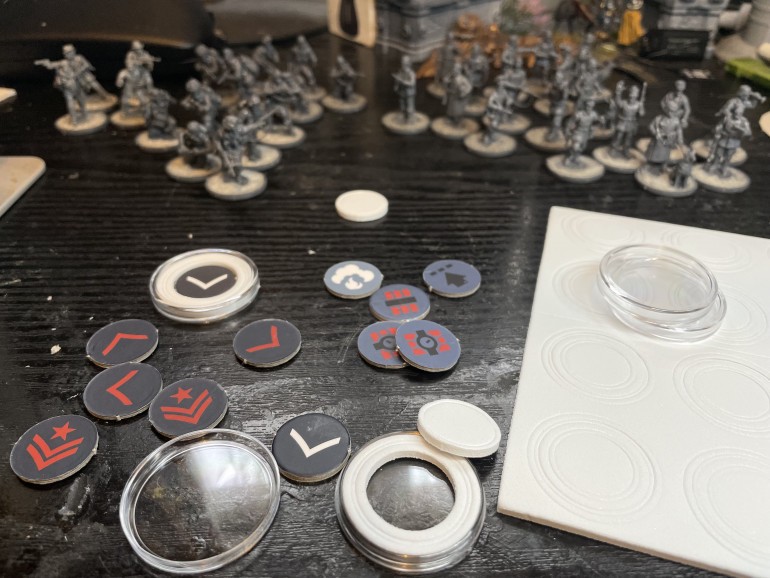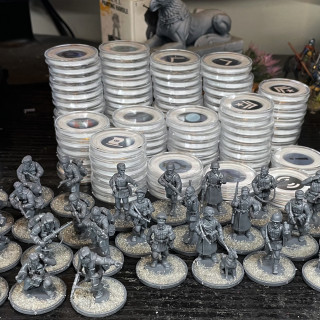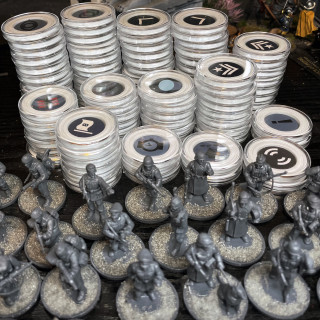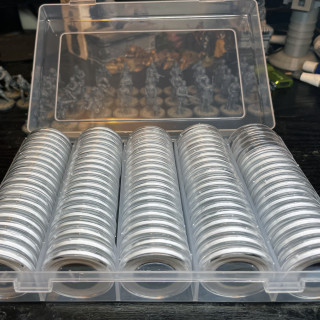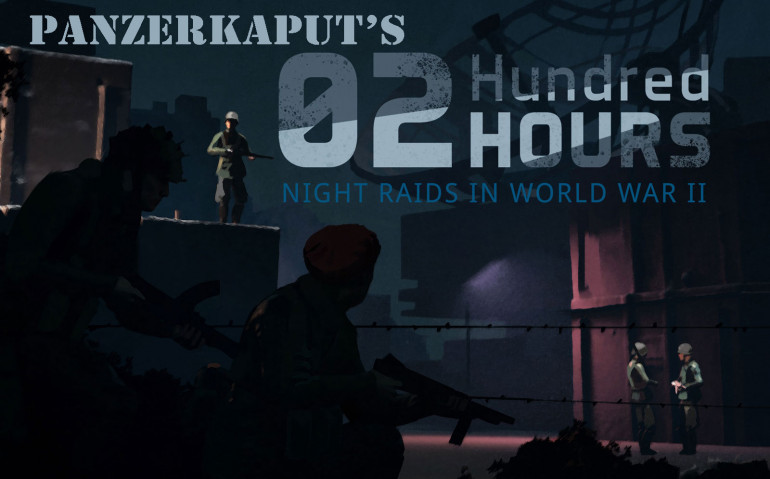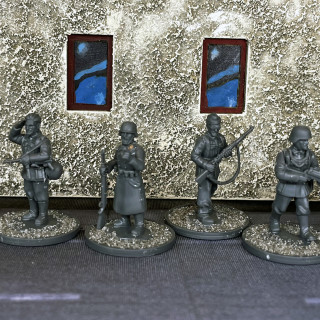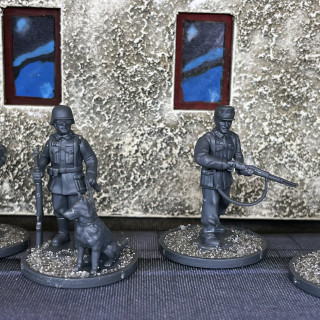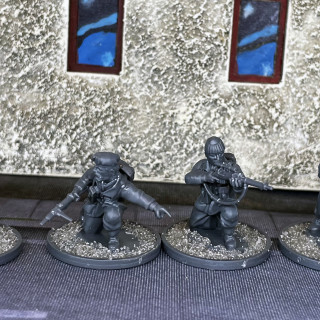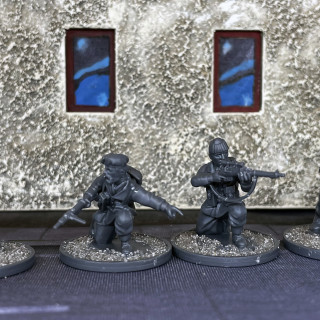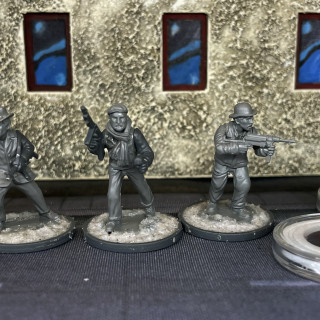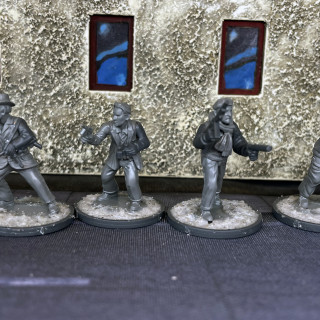
Broadsword Calling Danny Boy, Broadsword Calling Danny Boy
Recommendations: 414
About the Project
02 Hundred Hours is a skirmish wargame focusing on night-time raids in World War II. Inspired by classic war movies as well as historical events, battles are fast paced with roughly 10-20 models on either side. Field an elite force of Commandos, SAS, Paratroopers or Rangers to infiltrate the enemy lines under cover of darkness. Recruit SOE spies and local resistance fighters to bolster your chances. Launch attacks on radar stations, munition factories, airfields, bridges and rail lines. Sneak past sentries, take them out with silent attacks, or open fire with a devastating ambush. Plant charges to destroy your objective, assassinate a target or grab vital intel, then fight your way to safety before reinforcements arrive. Or play as the defenders, carefully setting patrol routes so your sentries can spot raiders in the shadows, utilise guard dogs, officers or even the dreaded Gestapo and make use of informants and intercepted transmissions to thwart the attackers’ plans.
Related Game: 02 Hundred Hours
Related Company: Grey For Now Games
Related Genre: Historical
This Project is Active
German Uniform for the Heer Guards
I have gone for the mixture of uniforms for my Heers guards, ranging for Early War uniforms to the Mid War uniform and my thinking is these are second line troops and would have their uniforms replaced once the serviceability of the old uniform was no longer. I am not totally sure if this would happen but I guess it would.
So I started is the early war greener field grey jacket and green trousers and I did this for all the troopers and officers in the high jack boots.
The Model 1936 Tunic (Early War) tone recipe is:
The based tunic colour with Vallejo Model Colour German Cam Ex Dark Green, highlighted with VMC German Uniform, and added further highlights of VMC Light Green Blue and VMC German Uniform at 50/50 mix.
Then I added a wash of Vallejo Model Colour German Cam Ex Dark Green, watered down with 5 parts water.
Colours used for the Model 1936 Tunic
Vallejo Model Colour German Cam Ex Dark Green
Vallejo Model Colour German Uniform
Vallejo Model Colour Light Green Blue
I worked on the grey trousers for the Model 1936 Tunic and to some of the overcoats.
The trouser and great coat (Early War) tone recipe is:
The based tunic colour with Vallejo Model Colour Dark Blue Grey, highlighted with VMC Neutral Grey, and added further highlights of VMC Light Grey.
Then I added a wash of Vallejo Model Colour Dark Blue Grey, watered down with 5 parts water.
Colours used for the Model 1936 Trouser
Vallejo Model Colour Dark Blue Grey
Vallejo Model Colour Neutral Grey
Vallejo Model Colour Light Grey
For the troops in the short boots and gaitered trousers, the Mid-War uniform or the Model 1940/41 Tunic and trouser, I when for the “new” field grey uniform colour.
The Model 1940/41 Tunic and trouser (Mid-War) tone recipe is:
The based tunic and trouser colour with Vallejo Model Colour German Camo Dark Green, highlighted with VMC German Field Grey, and added further highlights of VMC Green Grey.
Then I added a wash of Vallejo Model Colour German Camo Dark Green, watered down with 5 parts water.
Colours used for the Model 1940/41 Tunic and Trouser
Vallejo Model Colour German Camo Dark Green
Vallejo Model Colour German Field Grey
Vallejo Model Colour Green Grey
So it Starts for the Heer
I have primed the Heer guards for 02 Hundred Zero and have started on the skin tones and carrying on trying to get the skin colour right, I am after getting a bit of warm into the skin and I am thinking I am getting there. I have played around with the recipe and used a different wash this time.
The skin tone recipe is:
The base skin with Vallejo Model Colour Tan Earth, highlighted with VMC Tan Yellow, and added further highlights of VMC Iraqui Sand and Basic Flesh.
Then I added a wash of Army paint Light Tone and with an old Citadel Red Ink in a 2 to 1 mix of Strong Tone to Red and watered down the mix with 3 parts water.
Then I highlighted it again with VMC Tan Yellow and Iraqui Sand.
Colours used
Vallejo Model Colour Tan Earth
Vallejo Model Colour Tan Yellow
Vallejo Model Colour Iraqui Sand
Vallejo Model Colour Basic Flesh
Citadel Paints (OOP) Red ink
Army Painter Light Tone
German Uniforms of WWII plus a reference guide for Vallejo Paints
FALLSCHIRMJÄGER UNTEROFFIZIER (CORPORAL), 1944

02 – Fallschirmschützen Bluse camouflage sweatshirt in “Splittermuster” camo, rank insignia on the sleeves, Luftwaffe eagle on the right breast
03 – M-37 trousers
04 – M-38 gas mask in a tarpaulin bag
05 – 9 mm MP-40 SMG
06 – Ammo pouches for MP-40, main belt and webbing
07 – M-31 canteen in “Fliegerblau”- “aviation blue”
08 – M-31 breadbag
09 – folding shovel
10 – Ziess 6×30 binoculars
11 – Boots
GERMAN CAPTAIN (HAUPTMANN), 1940
02 – M-35 helmet with Heeres markings
03 – M-35 officers’ jacket, white markings on the collar tabs and shoulder straps (Waffenfarbe Weiss)- infantry
04 – M-34 officers’ belt
05 – Zeiss 6×30 binoculars
06 – SA sport badge
07 – Compass
08 – M-35 map pouch
09 – Holster for Luger P-08 pistol
10 – Officers’ gloves
11 – Boots
12 – Watch
GERMAN CAVALRY SERGEANT MAJOR (OBERWACHTMEISTER) 1939-40
02 – Feldgrau jacket with gold (“Waffenfarbe Goldgelb”) markings of the cavalry
03 – Steingrau cavalry breeches
04 – Black leather belt
05 – Holster for Luger P-08 pistol
06 – Leather webbing- “Koppeltraggestell”
07 – Cavalry boots with spurs
08 – M-38 gas mask
09 – Anti-mustard gas cloth
10 – Trumpet
GERMAN CORPORAL (UNTEROFFIZIER), 1939-1940

02 – M-35 steel helmet with Heeres markings
03 – Zeltbahn M-31 tent cloth in “Splittermuster” camouflage
04 – Grey (“Steingrau”) trousers
05 – Leather belt
06 – Anti-mustard gas cloth
07 – M-38 gas mask
08 – M-24 grenade
09 – Black leather ammo pouches
10 – M-31 aluminium canteen
11 – Boots
12 – 7.92 mm Mauser 98k rifle
13 – Seitengewehr 84/98 bayonet
14 – Wire cutting shears
PANZERTRUPPE LEUTNANT, 1939
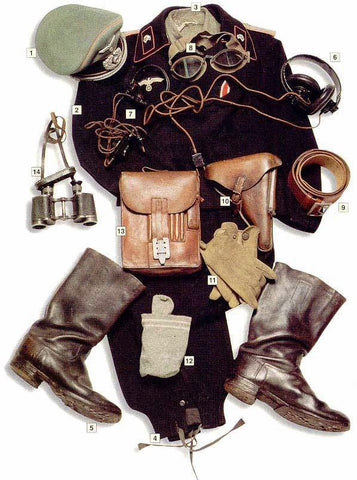
PRIVATE, VOLKSGRENADIER DIVISION, ITALY/GREECE, 1944

SS- HAUPSTURMFUHRER (CAPTAIN)

– ribbons: “Kriegsverdienstkreuz” (war service cross), medal for the winter campaign on the eastern front 1941/42, bronze SA sport badge
SS-REITER (PRIVATE), 8. SS-KAVALLERIE DIVISION “FLORIAN GEYER”, SUMMER 1944

WAFFEN SS STURMMANN (CORPORAL), NORMANDY 1944

SERGEANT MAJOR (FELDWEBEL), LUFTWAFFE, AFRICA, 1943

01 – M-41 field cap with Luftwaffe eagle
02 – M-41 Luftwaffe tropical jacket, yellow collar tabs of the flying personnel
03 – Linen trousers
04 – Main belt with holster for the P-08 pistol
05 – “Afrika” armband of the Luftwaffe’s African theater units
06 – Leather gloves
07 – Oxygen mask (bomber version)
08 – Linen pilots’ cap with earphones
09 – Life jacket
10 – Leather boots
11 – Aviation goggles
12 – Kappmesser M-37 knife
13 – “Hankart” watch
14 – Compass
15 – Map
16 – Deutsches Kreuz in Gold- Golden German Cross, established 1941
17 – Iron Cross 1st Class
18 – Luftwaffe pilot badge
19 – Bomber crew badge
20 – Pilot’s military ID
CAPTAIN (KAPITANLEUTNANT)- U-BOAT COMMANDER, 1941

01 – Officers’ jacket, Kapitanleutnant insignia
02 – Kninght’s Cross of the Iron Cross
03 – U-boat crew badge
04 – Unofficial badges of the 1st and 9th U-boat flotilas
05 – Cigarettes
06 – Kriegsmarine officers’ cap
07 – Leather gloves
08 – Leather “U-Boot-Päckchen” – U-boat battle dress
09 – Boots
10 – “Junghans” watch
11 – Naval binoculars
VALLEJO MODEL COLOUR PAINT GUIDE FOR WWII GERMAN UNIFORMS & EQUIPMENT
General
Uniforms: German Field Grey V70.830
Collar: Deep Green V70.970
Jack boots: Black V70.950
Low boots: German Brown Black V70.822
Waders: Field Grey V70.830
Webbing: German Cam Black Brown V70.822
Ammo pouches: German Cam Black Brown V70.822
Haversack: Deck Tan V70.986
Canteen: German Black Brown V70.822
Or Mahogany Brown V70.846
Mess Tin: Olive Green V70.967
Gas Mask: Neutral Grey V70.992
Helmet: German Grey V70.995
Reed Green Uniform: German Uniform V70.920
Basic Uniform 1939+
Tunic: German Uniform V70.920
Trousers: Neutral Grey V 992
Webbing: Black V70.950
Ordinance: Green Yellow Olive V 892
Field cap: German Field Grey V70.830
Helmet: Olive Green V70.967
Tunic Collar: Black Green V70.980
Basic Uniform 1941+
Tunic: German Field Grey WWII V 830
Trousers: German Field Grey WWII V70.830
Webbing: Black V70.950
Ordinance: Green Yellow Olive V70.892
Field cap: German Field Grey WWII V70.830
Helmet: Olive Green V70.967 / German Grey V70.995
Tunic Collar: German Field Grey WWII V70.830
Basic Uniform 1944+
Tunic: Russian Uniform V70.924
Trousers: Russian Uniform V70.924
Webbing: Black V70.950
Ordinance: Green Yellow Olive V70.892
Field cap: German Field Grey WWII V70.830
Helmet: Olive Green V70.967 / German Grey V70.995
Tunic: Collar Russian Uniform V70.924
Ammo Pouches: Dark Grey V70.994
Uniform Variations 1944+
Tunic: English Uniform V70.921
Trousers: English Uniform V 921
Webbing: Yellow Ochre V70.913 / Dark Grey V70.994
Ordinance: Green Yellow Ochre V70.913
Field cap: Russian Uniform V70.924
Helmet: Yellow Ochre V70.913
Anklets: Green V70.975
Tropical Uniform/Desert
Uniform: Yellow Ochre V70.913 / Khaki V70.988 / Desert Yellow V70.977
Webbing: Mahogany Brown V70.846 / Sand Yellow V70.916
Ordinance: Yellow Dark Sand V 847
Field cap: Yellow Ochre V70.913
Helmet: Tan Yellow V70.912
Boots: Red Leather V 818
Panzer Crew 1939-1945
Field Cap: Neutral Grey V70.992
Beret: Black V70.950
Officer Cap: German Uniform V70.920
Cap/Tunic/Trousers: Black V70.950 / Grey V70.994
Waffenfarbe: Sunset Red V70.802
Belt/Boots: Black V70.950 / Grey V70.994
Shirt/Gloves: Neutral Grey V70.992
Splinter Camo
Base Colour (pale): Pastel Green V70.885
Base Colour (dark): Russian Uniform V70.924
Base Colour (marsh): Buff V70.976
Brown Colour: Beige Brown V70.875
Green Colour: Luftwaffe Cam Green V70.823
Raindrop Colour: Black Green V70.980
Fallschirmjäger
Bread Bag: German Grey V70.995
Webbing/Pouches: Chocolate Brown V70.872
Water Bottles: Chocolate Brown V70.872
Holsters: Chocolate Brown V70.872
1939-1940 Plain Green
Helmet: German Grey V70.995
Smock/Helmet Cover: Green Grey V70.886
Trousers/Pouches: Field Grey V70.830
Crete-1945 Splinter
Smock/Cover: German Cam Beige (Base) V70.821
Luftwaffe Camo: Luftwaffe Cam Green V70.823 / Flat Brown V70.984
Trousers/Pouches: Field Grey V70.830
N. Africa and Italy Camo
Smock/cover: German Cam Beige (Base) V70.821
Luftwaffe Camouflage: Luftwaffe Cam Green V70.823 / Flat Brown V70.984
Trousers/Pouches: Desert Yellow V70.977
Italian Camo Pattern
Olive Grey (Base) V70.888
German Cam Medium Brown V70.826
Sand Yellow V70.916
General equipment
Zeltbahn base: V70.821, Zeltbahn Geometric pattern: V70.826, V70.890
SS Collars: Black / V70.896 Extra Dark Green
Haversack: V70.886 Green Grey / V70.986 Deck Tan / V70.819 Iraqi Sand / V70.977 Desert Yellow
Mess Tin / Gas Mask: V 995 German Grey
Helmet: V 995 German Grey
Ammo Cans: Dark Yellow V 978
SMG Ammo Pouches: V 914 Green Ochre
Map Cases ” ”
Map/Binoc Cases: GW Dark Flesh
Gebirgsjäger Anorak: 66% V 887 Brown Violet, 33% V 992 Neutral Grey
M39 Grenade: V 975 Green
Field Flask: V875 Beige Brown / V70822 Brown
Cook Pot: V790 Silver
M38 Gas Mask case: V896 Dark Green
Gas Cape: V975 Green / V70886 Green Grey
Spade Holder: V994 Grey
Scabbard – Black
The Finished SAS
Welcome to Captain William Vanderlyon and his unit of Golden Lions, a fiction unit of SAS troopers for my games, as i wanted that Boys Own, Battle, Commando comic feel to them.
I have finished the British from the 02 Hundred Hours starter set and I have painted them as SAS, in North West Europe, late war. I am pleased with the results of the Denison Smock and the overall look of them and those Wargames Atlantic figures as very nice indeed and paint up very well.
I went with the grassy, dirt bases for these and the German Heer guards I will be going for a gravel/stone bases.
Now to paint Jerry
Red Berets for the SAS
I have painted the red berets on the SAS in the NWE Theatre of War, as they had red berets and not light blue or sand berets, because they were dressed like British Paras.
Here below is the image I used to base my SAS on
The beret colour recipe is:
The beret colour with Vallejo Model Colour Burnt Cadmium Red, highlighted with of VMC Dark Red, and added further highlights of VMC Red/Dark Vermillion.
Colours used the webbing colour of the smock
Vallejo Model Colour Burnt Cadmium Red
Vallejo Model Colour Dark Red
Vallejo Model Colour Red/Dark Vermillion
British Webbing, Late War
I have finished the webbing on the soldiers, and I wanted that green Branco webbing that the British used in the later period of the Second World War. Look through the article below on British webbing and gosh trying to find that colour was a right pain. I went for the darker green colour are it was a nice contrast with the Denison Smock and Battledress.
The webbing colour recipe is:
The webbing base colour with Vallejo Model Colour Bronze Green, highlighted with 50/50 mix of VMC Bronze Green and VMC Pastel Green, and added further highlights of VMC Pastel Green.
Colours used the webbing colour of the smock
Vallejo Model Colour Bronze Green
Vallejo Model Colour Pastel Green
Denison Smock for the SAS
I have finished painting the Denison Smock worn by my British SAS, circa 1944, Northwest Europe, oh and the Paras and Commandos too. The Denison smock was a coverall jacket issued to Special Operations Executive (SOE) agents, the Parachute Regiment, the Glider Pilot Regiment, Air Landing Regiments, Air Observation Post Squadrons, Commando units, and other Commonwealth airborne units, to wear over their Battle Dress uniform during the Second World War. The garment was also issued as standard to the scout and sniper platoons of line infantry battalions.
The smock was initially worn over the paratrooper’s webbing equipment, but under his parachute pack and harness, as its primary purpose was to prevent the wearer’s equipment from snagging while emplaned or during a jump. It was equally useful for camouflage and as a windproof garment that provided a method of carrying ammunition or equipment. Contemporary photographs show that airborne troops preferred to wear the smocks under their webbing once they had landed.
The Denison Smock base colour recipe is:
The based smock with Vallejo Model Colour English Uniform, highlighted with VMC Khaki Grey, and added further highlights of VMC German Camo Beige WWII.
Then I added a wash of VMC English Uniform watered down the mix with 3 parts water.
Colours used the base color of the smock
Vallejo Model Colour English Uniform
Vallejo Model Colour Khaki Grey
Vallejo Model Colour German Camo Beige WWII
The Denison Smock green camouflage pattern colour recipe is:
The green for the camouflage pattern used for the smock, started with Vallejo Model Colour Russian Green/Camo Olive Green at a 2 part green to 1 part water, so it was slightly translucent, highlighted with VMC Russian Green/Camo Olive Green and VMC Pale Sand at 5 part green to 1 part sand, and a wash of VMC German Extra Dark Green at 1 part green and 5 part water.
I put the green down is large irregular patterns using a photo of a Denison Smock for reference. These smocks where actually hand painted with a mop, once the jacket was assembled.
Colours used the green camouflage pattern colour of the smock
Vallejo Model Colour German Extra Dark Green
Vallejo Model Colour Russian Green/Camo Olive Green
Vallejo Model Colour Pale Sand
The Denison Smock brown camouflage pattern colour recipe is:
The brown for the camouflage pattern used for the smock, started with Vallejo Model Colour Mahogany Brown at a 2 part green to 1 part water, so it was slightly translucent, highlighted with Vallejo Game Colour Tan and a wash of VMC Flat Brown at 1 part green and 5 part water.
I put the brown down is large irregular patterns using a photo of a Denison Smock for reference. These smocks where actually hand painted with a mop, once the jacket was assembled.
Colours used the brown camouflage pattern colour of the smock
Vallejo Model Colour Flat Brown
Vallejo Model Colour Mahogany Brown
Vallejo Game Colour Tan
Battledress and Helmets Done
I have painted the Khaki Battledress and the Bronze Green helmets, scarves and wooden hats for my British SAS for 02 Hundred Hours from Grey for Now Games. They are starting to take shape and the next stage is the Denison Smock for them.
The battledress recipe is:
The based battledress with Vallejo Model Colour Burnt Umber, highlighted with VMC English Uniform, and added further highlights of VMC Khaki Grey.
Then I added a wash of VMC Burnt Umber watered down the mix with 3 parts water.
Colours used the battledress
Vallejo Model Colour Burnt Umber
Vallejo Model Colour English Uniform
Vallejo Model Colour Khaki Grey
The Bronze Green recipe is:
The base skin with Vallejo Model Colour German Extra Dark Green, highlighted with VMC Bronze Green, and added further highlights of VMC Camo Olive Green/Russian Green and a final highlight of VMC Camo Olive Green/Russian Green and VMC Ivory at three part Russian Green and one part Ivory.
Colours used
Vallejo Model Colour German Extra Dark Green
Vallejo Model Colour Bronze Green
Vallejo Model Colour Camo Olive Green/Russian Green
Vallejo Model Colour Ivory
Starting the British SAS
I have started my 02 Hundred Hours journey and I have started with painting the British SAS raiders first. I’ve been painting about with my skin recipe; it’s worked but I think it need a little refining.
The skin tone recipe is:
The base skin with Vallejo Model Colour Tan Earth, highlighted with VMC Tan Yellow, and added further highlights of VMC Iraqui Sand and Basic Flesh.
Then I added a wash of Army paint Strong Tone and VMC Transparent Red is a 2 to 1 mix of Strong Tone to Red and watered down the mix with 3 parts water.
Then I highlighted it again with VMC Tan Yellow and Iraqui Sand.
Colours used
Vallejo Model Colour Tan Earth
Vallejo Model Colour Tan Yellow
Vallejo Model Colour Iraqui Sand
Vallejo Model Colour Basic Flesh
Vallejo Model Colour Red Transparent
Army Painter Strong Tone
Next to paint the battledress.
#wargamesatlantic #greyfornowgames #02hundredhours #historicalgamer #wargamer
And Now It Starts, Operation Spamalot
I have assembled and primed all the plastics from the Starter Box for both the German Heer and British SAS, 18 for the Gerry and 12 for the Brits, plus 4 French resistance/SOE Agents. I have also assembled and primed the characters for the expansion set, Guards of Facility 9.
I am going to start painting the British SAS first and once there are finished paint Gerry. I realised that I have a ton of scenery for Very British Civil War that might be of use for this so am I going to dig them out and see.
Colour Guide – German Infantry
German Infantry, Germans in Greatcoats, Late War Germans
Item Colour Vallejo Model Colour
Helmet Dark Grey German Dk Grey 70.995,
Uniform Field Grey German Field Grey WW2 70.830
Uniform (variant early war) Reed Green German Uniform 70.920
Greatcoat Field Grey German Field Grey WW2 70.830
Webbing Black Black 70.950
Bread Bag, Shovel Cover Khaki Green Russian Uniform 70.924
Gasmask Tin, Canteen Dark Green German Dark Green 70.896
Canteen (late war) Khaki Yellow Desert Yellow 70.977
Water bottle Cover Brown German Camo Red Brown 70.826, Flat Brown 70.984
Water bottle Lid & strap Black Black 70.950
Anklets / Gaiters Dark Green German Dark Green 70.896
Boots Black Black 70.950
Introduction
This guide will help you to quickly paint units of soldiers to look good on a war games table. Uniform notes, paint references and painting tips are included.
Historical Notes
Uniform
Uniforms were produced in field grey (Feldgrau) but the colour changed during the war years. At the start, it was a dark grey with a blue green tone. Towards the end of the war, cloth supplies were limited so many variations ranging from mid grey to brownish grey were used. Late war variations can
be made by mixing grey or brown to the standard shade.
Vehicles in the early war period were grey. From 1943 onwards, new vehicles were painted in yellow ochre. Camouflage was added using red brown and dark green. Metal items such as heavy weapons, ammunition boxes and mess tins were grey in the early period and ochre in the late period. However, even towards the end of the war, grey items were still common.
Bread bags and anklets were produced in field grey but being cotton faded rapidly. Water bottles had a black painted aluminium cup which served as the lid and a brown wool cover.
Squad Organisation and Equipment
Insignia
German army soldiers wore Heer symbols on the collar. In the early war period, this went on a dark green patch but later, it was onto grey fabric. These can be simulated by painting a small white = symbol on the collar.
On the left breast the eagle symbol was worn. This can be painted in white or light grey. The same was often on the front of cloth caps.
Shoulder boards were black with coloured piping on the edge
Artillerie (artillery) – Red
Aufklärungs (reconnaissance) – Yellow
Feldgendarmerie (field police) – Orange
Infanterie (infantry) – White
Jäger/Gebirgsjäger (light infantry/mountaineer) – Light Green
Panzergrenadier (armored/motorized infantry) – Dark Green
Pionier (engineer) – Black
Sanitäter/Artz (medic/doctor) – Cornflower Blue
Panzerjäger (tank destroyer) -Pink
Panzer (black wool center w/pink piping; same as SS).
Colour Guide – British Airborne/SAS
British Airborne, SAS Europe
Item Colour Vallejo Model Colour
Beret Airborne Maroon Dark Red 70.946
Helmet Dark Green Russian Green 70.894, Bronze Green 70.897
The airborne scarf was camouflaged in brown and green.
Scarf Dark Green Russian Green 70.894, Bronze Green 70.897
Scarf Brown Mahogany Brown 70.846, Flat Brown 70.984
The Denison Smock was camouflaged with blotches of brown, black and green on a pale coloured background.
Base Beige German Camo Beige 70.821
Base (option) Pale Green Pastel Green 70.885
Camouflage Brown Mahogany Brown 70.846, Flat Brown 70.984
Camouflage Dark Green Russian Green 70.894, Bronze Green 70.897
Camouflage Black Black 70.950
Uniform Khaki US Field Drab 70.973, English Uniform 70.921, Flat Earth 70.983
Webbing & Pouches Beige German Camo Beige 70.821
Anklets / Gaiters Sand Iraqi Sand 70.819, Dark Sand 70.847
Boots – Soldiers Black Black 70.950
Notes
British uniforms were consistent over all branches of the army. Commandos, infantry, artillery and many Commonwealth forces engaged in Europe had only slight variations of insignia and beret.
Airborne forces were similar but with the addition of a camouflaged Denison smock jacket. A few specialists’ units also received camouflaged trousers.
Khaki cloth was mostly a brown shade and relatively colourfast. Vallejo English uniform 70.921 is very dark and brown, Flat Earth 70.984 or US Field Drab 70.973 are lighter tones. Canadian produced cloth was slightly greener in tone.
Webbing, anklets and ammunition pouches were issued in Sand and Green shades. They were made from were cotton canvas and faded rapidly. In theory, green is correct for the late war period in Europe, but soldiers were issued with both colours. Green ammunition pouches were sometimes worn with sand
coloured webbing and vice versa.
British made vehicles and metal items were dark green (Reflective Green). American made vehicles were olive green drab (US Dark Green 70.893).
Further Reading
Books
General
Andrew Mollo: The Armed Forces of World War 2 (Little, Brown and Company)
This book is a very useful overview of uniforms and insignia. There are 250 colour drawings and 100 photographs which cover every nation involved in WW2. The original 1981 version is a large format book. There is an A5 reprint that does not include the Eastern front.
Chris McNab: 20th Century Military Uniforms: 300 Uniforms from Around the World (Grange Books PLC)
This book is similar in style to Andrew Mollo’s book and has many of the same illustrations.
Osprey books are also very good but there are several which touch the subject, so it is difficult to recommend one item.
Britain
Martin Brayley: The World War II Tommy: British Army Uniforms European Theatre 1939-45 (The Crowood Press Ltd)
A very useful book with colour photographs showing original uniforms and equipment.
Jean Bouchery: 1944-45 British Soldier: From D-Day to V-Day: Pt. 1 (Histoire & Collections)
Jean Bouchery: 1944-45 British Soldier: From D-Day to V-Day: Pt. 2 (Histoire & Collections)
Taken together these two books are very comprehensive. Part 1 covers uniforms. Part 2 covers vehicles and weapons. Both are illustrated with diagrams and colour photographs showing original uniforms and equipment
Colour Guide – British Commandos
Commandos – North West Europe (Normandy, etc)
Item Colour Vallejo Model Colour
Beret Commando Green Deep Green 70.970
Helmet Dark Green Russian Green 70.894, Bronze Green 70.897
Helmet Cover Khaki Green Russian Uniform 70.924
Leather Jerkin Brown Mahogany Brown 70.846, Flat Brown 70.984
Uniform Khaki US Field Drab 70.973, English Uniform 70.921, Flat Earth 70.983
Backpack Khaki Green Russian Uniform 70.924
Backpack straps Beige German Camo Beige 70.821
Webbing & Pouches Sand Iraqi Sand 70.819, Dark Sand 70.847
Webbing (variant) Beige German Camo Beige 70.821
Webbing (variant) Pale Green Deck Tan 70.912, Pastel Green 70.885
Anklets / Gaiters Beige German Camo Beige 70.821
Boots – Soldiers Black Black 70.950
Notes
British uniforms were consistent over all branches of the army. Commandos, infantry, artillery and many Commonwealth forces engaged in Europe had only slight variations of insignia and beret. A few specialists’ units also received camouflaged jackets and trousers.
Khaki cloth was mostly a brown shade and relatively colourfast. Vallejo English uniform 70.921 is very dark and brown, Flat Earth 70.984 or US Field Drab 70.973 are lighter tones.
Webbing, anklets and ammunition pouches were issued in Sand and Green shades. They were made from were cotton canvas and faded rapidly. In theory, green is correct for the late war period in Europe, but soldiers were issued with both colours. Green ammunition pouches were sometimes worn with sand
coloured webbing and vice versa.
British made vehicles and metal items were dark green (Reflective Green). American made vehicles were olive green drab (US Dark Green 70.893).
Insignia
Commandos wore the commando badge on the shoulder. It can be simulated by painting a black circle and adding two vertical and horizontal strokes in red to form #. The unit badge was a curved shape at the top of the shoulder. For commandos, this had a red symbol and white text.
Further Reading
Books
General
Andrew Mollo: The Armed Forces of World War 2 (Little, Brown and Company)
This book is a very useful overview of uniforms and insignia. There are 250 colour drawings and 100 photographs which cover every nation involved in WW2. The original 1981 version is a large format book. There is an A5 reprint that does not include the Eastern front.
Chris McNab: 20th Century Military Uniforms: 300 Uniforms from Around the World (Grange Books PLC)
This book is similar in style to Andrew Mollo’s book and has many of the same illustrations.
Osprey books are also very good but there are several which touch the subject, so it is difficult to recommend one item.
Britain
Martin Brayley: The World War II Tommy: British Army Uniforms European Theatre 1939-45 (The Crowood Press Ltd)
A very useful book with colour photographs showing original uniforms and equipment.
Jean Bouchery: 1944-45 British Soldier: From D-Day to V-Day: Pt. 1 (Histoire & Collections)
Jean Bouchery: 1944-45 British Soldier: From D-Day to V-Day: Pt. 2 (Histoire & Collections)
Taken together these two books are very comprehensive. Part 1 covers uniforms. Part 2 covers vehicles and weapons. Both are illustrated with diagrams and colour photographs showing original uniforms and equipment
Colour Guide – British Infantry
British Infantry Commonwealth Forces
Item Colour Vallejo Model Colour
Beret Artillery, AFV Black Black 70.950
Beret Infantry Khaki US Field Drab 70.973, English Uniform 70.921, Flat Earth 70.983
Helmet Dark Green Russian Green 70.894, Bronze Green 70.897
Helmet Cover Khaki Green Russian Uniform 70.924
Leather Jerkin Brown Mahogany Brown 70.846, Flat Brown 70.984
Uniform Khaki US Field Drab 70.973, English Uniform 70.921, Flat Earth 70.983
Backpack Khaki Green Russian Uniform 70.924
Backpack straps Beige German Camo Beige 70.821
Webbing & Pouches Sand Iraqi Sand 70.819, Dark Sand 70.847
Webbing (variant) Beige German Camo Beige 70.821
Webbing (variant) Pale Green Deck Tan 70.912, Pastel Green 70.885
Anklets / Gaiters Beige German Camo Beige 70.821
Boots – Officer Tan US Tan Earth 70.874
Boots – Soldiers Black Black 70.950
Notes
British uniforms were consistent over all branches of the army. Commandos, infantry, artillery and many Commonwealth forces engaged in Europe had only slight variations of insignia and beret.
Airborne forces were similar but with the addition of a camouflaged Denison smock jacket. A few specialists’ units also received camouflaged trousers. Khaki cloth was mostly a brown shade and relatively colourfast. Vallejo English uniform 70.921 is very dark and brown, Flat Earth 70.984 or US Field Drab 70.973 are lighter tones. Canadian produced cloth was slightly greener in tone.
Webbing, anklets and ammunition pouches were issued in Sand and Green shades. They were made from were cotton canvas and faded rapidly. In theory, green is correct for the late war period in Europe, but soldiers were issued with both colours. Green ammunition pouches were sometimes worn with sand coloured webbing and vice versa.
British made vehicles and metal items were dark green (Reflective Green). American made vehicles were olive green drab (US Dark Green 70.893).
Insignia
The unit badge was a curved shape at the top of the shoulder. For most infantry regiments this was red background and white text.
Further Reading
Books
General
Andrew Mollo: The Armed Forces of World War 2 (Little, Brown and Company)
This book is a very useful overview of uniforms and insignia. There are 250 colour drawings and 100 photographs which cover every nation involved in WW2. The original 1981 version is a large format book. There is an A5 reprint that does not include the Eastern front.
Chris McNab: 20th Century Military Uniforms: 300 Uniforms from Around the World (Grange Books PLC)
This book is similar in style to Andrew Mollo’s book and has many of the same illustrations.
Osprey books are also very good but there are several which touch the subject, so it is difficult to recommend one item.
Britain
Martin Brayley: The World War II Tommy: British Army Uniforms European Theatre 1939-45 (The Crowood Press Ltd)
A very useful book with colour photographs showing original uniforms and equipment.
Jean Bouchery: 1944-45 British Soldier: From D-Day to V-Day: Pt. 1 (Histoire & Collections)
Jean Bouchery: 1944-45 British Soldier: From D-Day to V-Day: Pt. 2 (Histoire & Collections)
Taken together these two books are very comprehensive. Part 1 covers uniforms. Part 2 covers vehicles and weapons. Both are illustrated with diagrams and colour photographs showing original uniforms and equipment
British Webbing
I have decided to paint my British SAS first and two this I am going to have to find out how to find. Denison Camo pattern and what colour is British webbing?
To this end I found this article on the net.
The point of this article is to make people aware that they can greatly improve the appearance of their WW2 British figures by painting the webbing equipment, and to promote more research on the subject of “Blanco“, the use of which affects the colour one might choose.
This is a topic I approach with some trepidation, since the subject of colour always starts arguments, because its interpretation is very subjective; however, I think the information I’ve compiled is quite interesting, and certainly relevant to my own models, and thus might be of interest to others.
British Webbing was all issued in a pale tan /khaki colour, some yellowish, some slightly greenish or neutral. The colour varied somewhat depending on where it was manufactured: typically, the Canadian manufactured versions were a strong yellow ochre shade.
Most of the 1/6th offerings are too pale, and the texture is greatly improved by painting anyway: it unifies the surface of the various fabrics used to make them. Use variations of Vallejo 914 Green Ochre, or 880 Khaki grey, lighter or yellower as you prefer. You can see the problem in this pic:
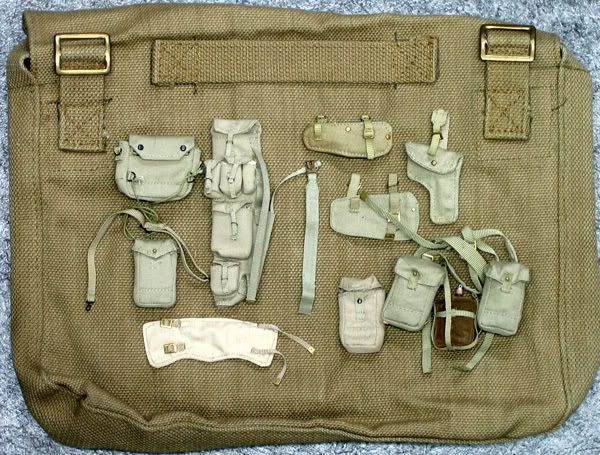
All soldiers issued with a set of webbing would have applied a commercial cleaner known as “Blanco“ at some time to their own personal webbing: originally developed by Pickerings before the Great War to cover stains on webbing by applying a matching cleaner, this had developed into a range of colours by WW2, and its application could modify the colour considerably. It was used at one extreme to make it look smart, and at the other to help with camouflage.

The different companies producing it ( Pickerings , Properts etc) had their own shades, which were supposed to conform to War Office specifications, but there was inevitable variation.
Which shade was used depended on Regimental practice and Theatre of War. It was not unknown for the battalion to use one colour for parades, and another when posted overseas. Unfortunately, we can never be sure exactly which shade was used from B/W pics, and colour pics are pretty rare, so unless we have veterans’ testimony we shall never know.
These colour pics are an indication, the quality of some of them is pretty dreadful, but they do at least prove the point that webbing was not worn in the pale colour provided by the 1/6th manufacturers:
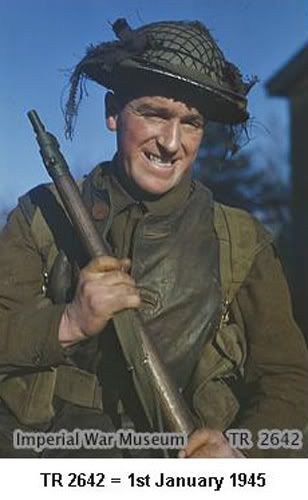

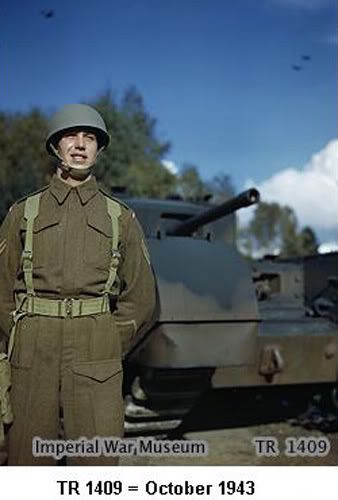
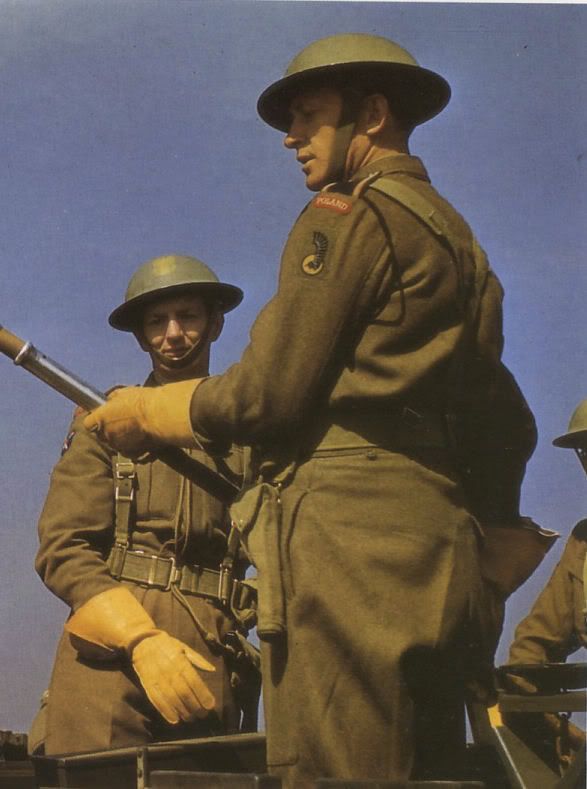
Most of these appear to show Khaki Green Light.
This one shows a mid-olive: might be faded KG3:
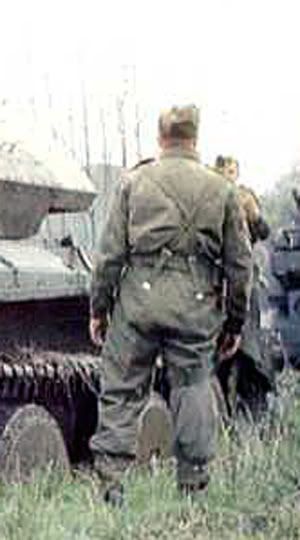
And these chaps, taken in strong sunlight and with a yellow cast I can’t remove with photobucket, may be wearing Buff or Khaki: I doubt they never used Blanco, since this is training at Bovington, and there would be lots of occasions for parades:

I am now certain about four shades: there were definitely several others, but I don’t have exact enough evidence to produce names and matches for them at present.
Here’s a colour chart, with suggested mixes from the Vallejo range: ~
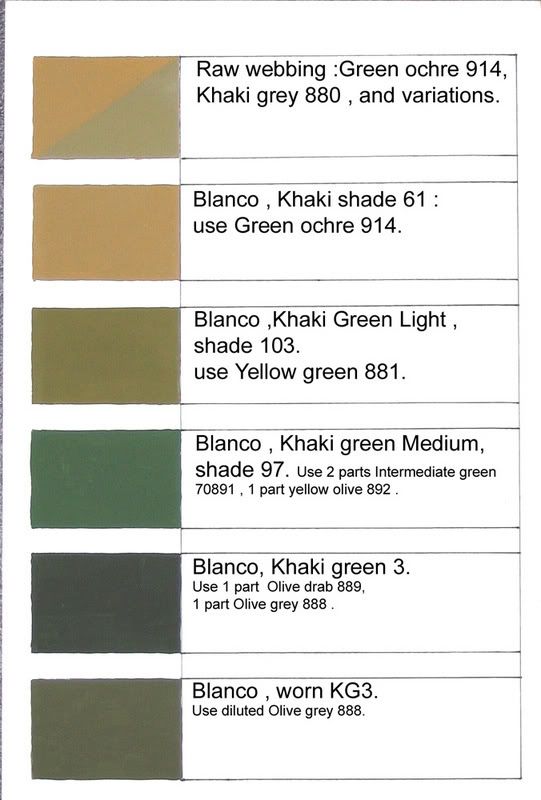
[ERROR: THE SECOND COLOUR DOWN IS ACTUALLY “BUFF ” RATHER THAN KHAKI 61. For the Khaki 61 please look at the top chip, right: Vallejo Khaki grey 880.]
The exact shade would depend on how thickly it was applied.
Broadly, in 1939, as far as we can tell, all the colours were available, and the colour pics we do have suggest that KGL and Khaki were the commonest shades throughout the war: if in doubt, use them.
In the Desert and Sicily, the webbing was scrubbed rather than blancoed, and bleached by the sun, which made it appear a very pale straw colour.
In time for D-Day, and thereafter in N.W Europe and Italy, judging by veterans’ testimony, the dark olive green KG3 seems to have been more popular, though the Khaki and the KGL were also still in use.
Troops in the Far East (essentially Burma & Malaya), who were based in India, originally wore pale Khaki Drill uniforms, and their webbing was coloured to match.
After the initial catastrophic defeats, the uniforms were hastily changed to jungle green, and the webbing vat-dyed to match. It was so damp in Burma that blanco would have been useless anyway (it’s water-soluble). The webbing colour quickly faded to a grey-brown shade.
In the field, replacement items would probably remain in the raw state, and things like Utility pouches, Bren Hoglegs etc. would probably never have been Blancoed in the first place: on a model, it’s best to paint them raw webbing colour.
Troops setting out for a particular operation (typically, the Airborne) or Theatre would almost certainly have travelled with their personal webbing newly blancoed for camouflage: service in the field would have faded and dirtied it pretty quickly.
Snipers in N.W. Europe blancoed their webbing green (probably KG3) in the field for camouflage and painted their brasses with green paint (personal testimony); but I don’t think most other infantry would have bothered in combat zones.
The British Army was inordinately fond of bullshit: for parades, all units would blanco their personal webbing in the shade preferred by the Regiment: these could be rather eccentric shades, such as black or straw yellow, and all brasses would be polished to a mirror finish.
The Military Police always used white webbing, even in combat zones: their role was largely traffic direction and prisoner handling behind the frontline.
Brayley & Ingram’s “WW2 Tommy “ has lots of examples of blancoed webbing, and though many of their pics show a rather chaotic jumble of blancoed and unblancoed items, this is no fault of theirs: the real blanco is very rare collector’s item nowadays, and too precious to be used for preparing parade-finish webbing for a book.
I cannot urge you too strongly, if you want to understand British equipment and uniforms, to get these books:
Brayley & Ingrams:
“The British Tommy in WW2 “; “Khaki Drill & Jungle Green “: both Crowood press.
Brayley: “British Webbing equipments of the two World Wars “Europa Militaria No.22,
Gordon:” The Equipment of the British Soldier “; one of three paperbacks on Uniforms, Weapons and Equipment.
I think it’s worth emphasising that ALL the colours were in use through the war: I’ve found no evidence that everyone on D-Day, for instance, wore KG3, any more than any other colour; or that the BEF all wore pea-green: I would be delighted to be proved wrong if someone can produce better evidence. These ideas, perhaps the result of re-enactment societies’ activities, can achieve the status of urban myths.
To help out, without infringing copyright by copying from books, here are some pics of my own figures to show the variations that were in use in different Theatres: they are result of some research, but are merely an indication of colour, rather than absolute references. All these are rebuilt scale webbing sets rather than straight out of the box, but the colours will work equally well on the commercial versions: ~
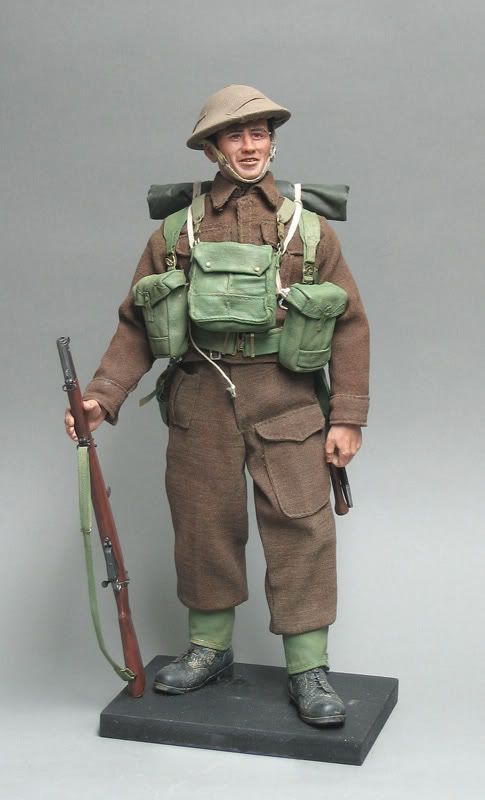
BEF 1940, wearing Khaki Green Medium shade 97: mixing this without it looking very bright is tricky, and I admit this might be a bit bright.

Western Desert: scrubbed and bleached webbing, no Blanco.
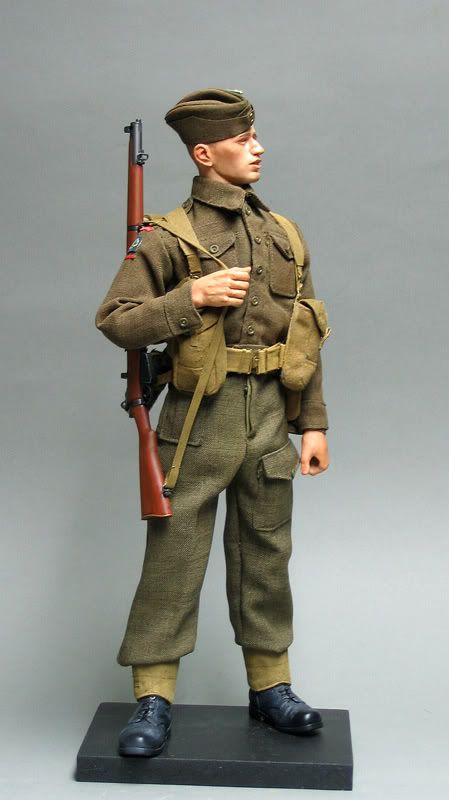
KOYLI 1943: Khaki Blanco, shade 61.
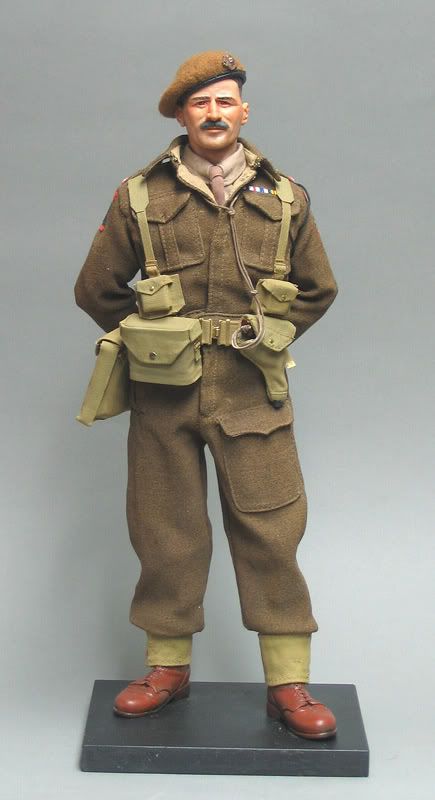
Officer’s set: Khaki Green Light: this is, I reckon, the commonest colour: we were still using this in the Cadet Force in 1964!
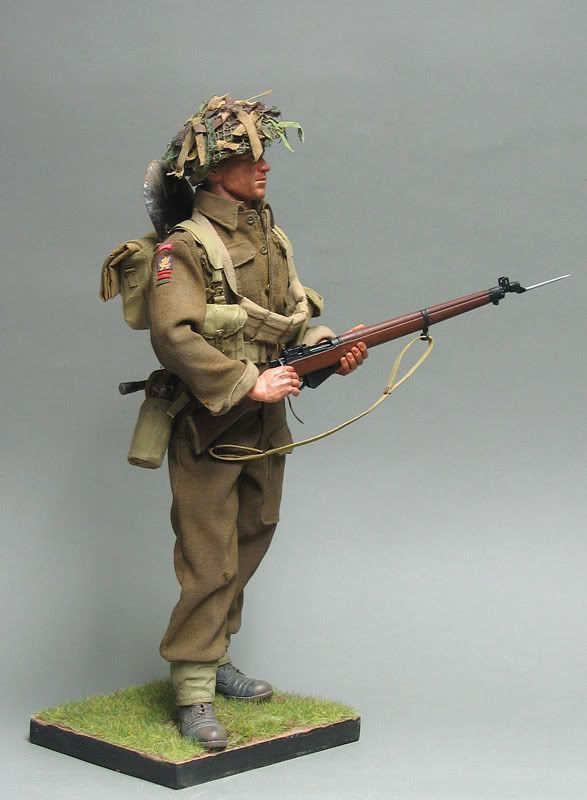
Dorsets in Normandy: Khaki Green Light again but worn and faded.
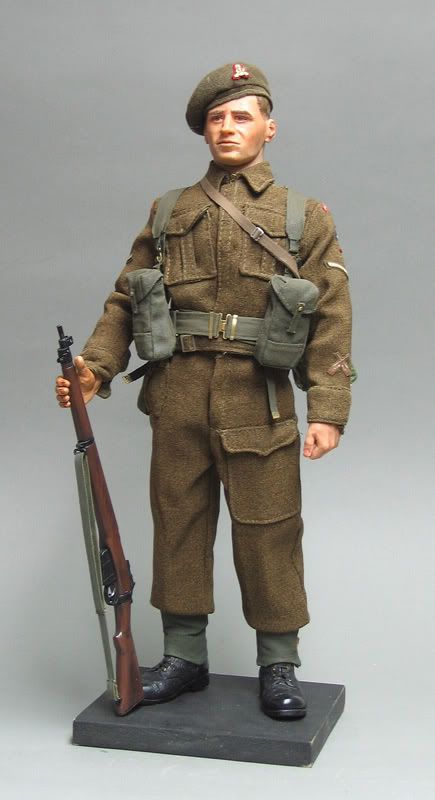
D.of Ws before D.Day : Khaki Green 3: this is real Blanco on this model!
A thick application produces this dark Olive colour.
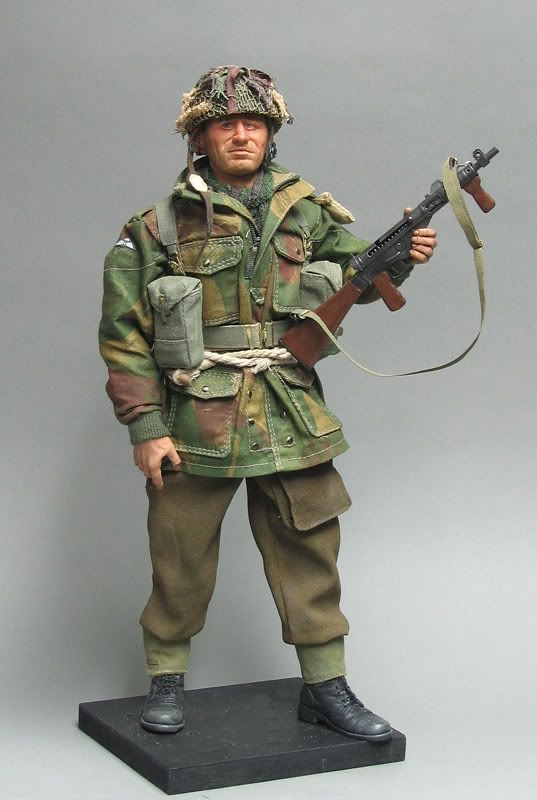
A Para at Arnhem: also, KG3, but thinly applied and worn it can look even greyer than this.
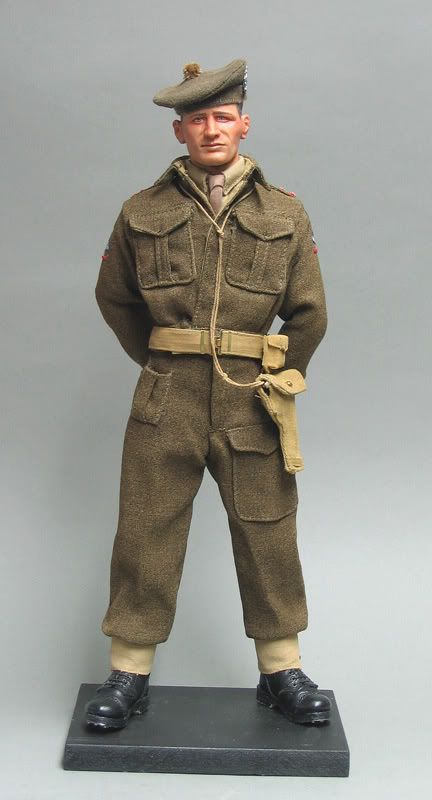
KOSB Officer in Germany 1945: Buff Blanco for Parade (use Vallejo Green Ochre 914). I don’t have a sample of this, but I’ve used it myself, and this is pretty close. Just a bit lighter than Khaki 61.
Finally, two of the figures holding real blanco samples for comparison: thanks to Chris W for these:
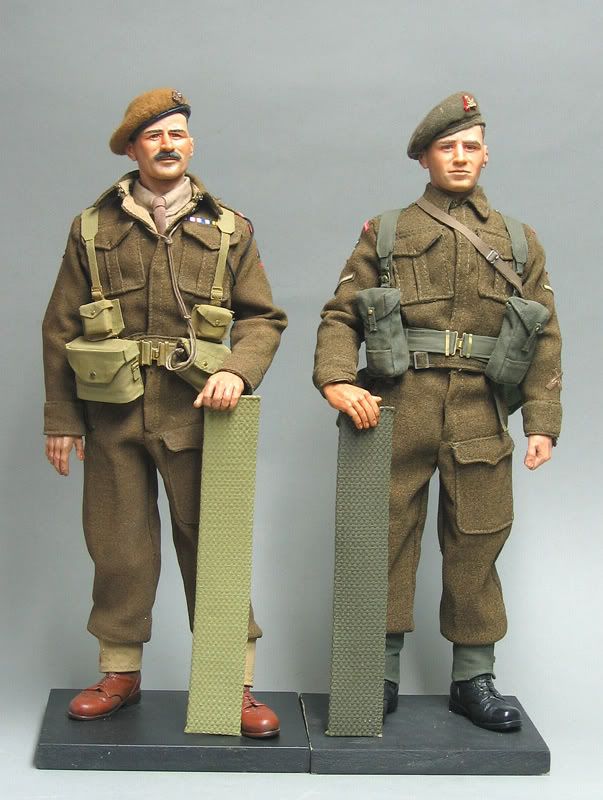
_____________________________________________________________
If you go to the trouble of painting the webbing, it might be worth remembering a few other points for authenticity when finishing figures: ~
The groundsheet/cape usually carried beneath the flap of the haversack was issued in pale or mid-khaki: unfortunately, the commercial 1/6th ones are all green. Repaint, or remake from a piece of suitable fabric.
The same applies to the five-pocket rifle ammo bandolier: pale tan, not green.
The e-tool helve should have the metal bayonet fitting at the thin end cut off: these were not really in use before the end of the war.
This figure shows the various colours that might appear on a single man: note the Utility pouches at his feet, still unblancoed :~

This is the Khaki Green Medium Blanco again: rather dirty and worn, and much less bright than the BEF figure.
The gaiters would normally be blancoed the same as the rest of the set. Later versions had leather straps: these were issued as pinkish leather but would be blacked for parades.
Thanks again to everyone for their help: and if you can find any more COLOUR pics, especially showing the Olive shades.
Coin Protectors for my Tokens
02 Hundred Hours Starter set comes with over 100 19mm tokens for the game and I wanted to protect them from the rigours of gaming, being drawn from a bag, etc and there are two ways I could have done this.
Firstly, I could have replaced all the tokens with MDF ones, but no one does them at the moment.
Secondly, I could use coin protectors for them.
There is a third version and thats using the technique Gerry used in his Gerry Can, turning the tokens into buttons but I am too lazy for that.
So I went for the coin protector and went for Coin Capsules Container Plastic Coin Holder Protect Gasket Coin Case with Storage Organizer Box for Coin Collection Supplies Fit 5 Sizes 17/20/25/27/30mm, with the coin holder case included 100 foam gaskets, adjust the inside diameter of the coin case and prevent coins from shaking and rubbing. The inner diameter of the foam gaskets is 18mm, 21mm,25mm, 27mm and 30 mm, suit for holding most kinds of coins, easy to separate the foam rings from the EVA foam pads based on your coin’s size and put the coin in the capsules.
I thought that they looked smarter than simply just having the tokens in the plastic capsule and yes, it is a matter of taste.
You simply punch out the centre EVA form at the size you want, 19/20mm in this case, and then put them into the capsule and close it.
Simples
Videos from Grey for now games on the Game Play
Following are some videos from Grey for Now Games on how to play 02 Hundred Hours
This One from Some Reprobates
All the Miniatures from the Games Assembled
I have finished assembling and basing all the miniatures for the games plus 4 extra SOE Agents/Partisans. I love the lipped bases that Wargames Atlantic have done with a hole for a 2mm magnet to fit in and it covers the puddle base of the figure too. I have used Vallejo Ground texture for the bases and now they are ready for priming.










































